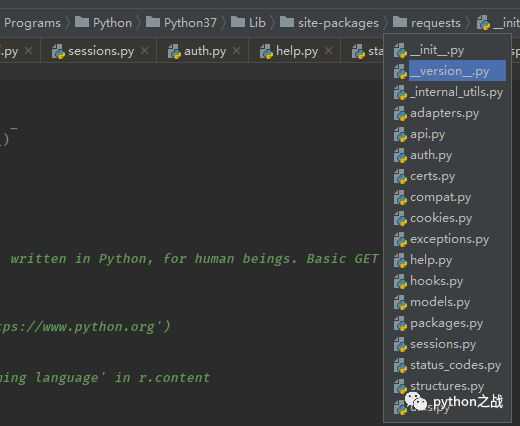requests库核心API源码分析
2021-01-25 18:15
标签:others create ide `` dia cep control 接口 mapping requests库是python爬虫使用频率最高的库,在网络请求中发挥着重要的作用,这边文章浅析requests的API源码。 该库文件结构如图: 提供的核心接口在__init__文件中,如下: requests常用方法在api.py文件中,源码如下: 常用的get、post、put、optins、delete方法都在该文件中实现,这些方法都是使用内部封装的一个模块:request,而request是对session.request内部模块的封装,提供一个上下文管理。 继续看最为核心的session.request模块源码: 在这里提交过来的请求信息将组装成Request请求对象,并对其中的配置参数进行合并,然后将Request请求和配置参数发送给self.send,来请求下载,继续看self.send 当然在self.send中核心的是下面几行行代码: 如果还有问题未能得到解决,搜索887934385交流群,进入后下载资料工具安装包等。最后,感谢观看! 分别进行请求,并将请求响应内容构造成响应对象r,其中又引入本地模块adapter,该模块主要负责请求处理及其响应内容。 requests库实现很巧妙,对cookie保持、代理问题、SSL验证问题都做了处理,功能很全,其中细节不仔细去研读很难理解,这里只是对其实现过程做一个浅析,如果有感兴趣的同学,可以仔细研读每个模块和功能,其中有奥妙。 requests库核心API源码分析 标签:others create ide `` dia cep control 接口 mapping 原文地址:https://www.cnblogs.com/pypypy/p/12003908.html
from . import utils
from . import packages
from .models import Request, Response, PreparedRequest
from .api import request, get, head, post, patch, put, delete, options
from .sessions import session, Session
from .status_codes import codes
from .exceptions import (
RequestException, Timeout, URLRequired,
TooManyRedirects, HTTPError, ConnectionError,
FileModeWarning, ConnectTimeout, ReadTimeout
)
# -*- coding: utf-8 -*-
"""
requests.api
~~~~~~~~~~~~
This module implements the Requests API.
:copyright: (c) 2012 by Kenneth Reitz.
:license: Apache2, see LICENSE for more details.
"""
from . import sessions
def request(method, url, **kwargs):
"""Constructs and sends a :class:`Request
def request(self, method, url,
·······
# Create the Request.
req = Request(
method=method.upper(),
url=url,
headers=headers,
files=files,
data=data or {},
json=json,
params=params or {},
auth=auth,
cookies=cookies,
hooks=hooks,
)
prep = self.prepare_request(req)
proxies = proxies or {}
settings = self.merge_environment_settings(
prep.url, proxies, stream, verify, cert
)
# Send the request.
send_kwargs = {
‘timeout‘: timeout,
‘allow_redirects‘: allow_redirects,
}
send_kwargs.update(settings)
resp = self.send(prep, **send_kwargs)
return resp
def send(self, request, **kwargs):
"""Send a given PreparedRequest.
:rtype: requests.Response
"""
# Set defaults that the hooks can utilize to ensure they always have
# the correct parameters to reproduce the previous request.
kwargs.setdefault(‘stream‘, self.stream)
kwargs.setdefault(‘verify‘, self.verify)
kwargs.setdefault(‘cert‘, self.cert)
kwargs.setdefault(‘proxies‘, self.proxies)
# It‘s possible that users might accidentally send a Request object.
# Guard against that specific failure case.
if isinstance(request, Request):
raise ValueError(‘You can only send PreparedRequests.‘)
# Set up variables needed for resolve_redirects and dispatching of hooks
allow_redirects = kwargs.pop(‘allow_redirects‘, True)
stream = kwargs.get(‘stream‘)
hooks = request.hooks
# Get the appropriate adapter to use
adapter = self.get_adapter(url=request.url)
# Start time (approximately) of the request
start = preferred_clock()
# Send the request
r = adapter.send(request, **kwargs)
# Total elapsed time of the request (approximately)
elapsed = preferred_clock() - start
r.elapsed = timedelta(seconds=elapsed)
# Response manipulation hooks
r = dispatch_hook(‘response‘, hooks, r, **kwargs)
# Persist cookies
if r.history:
# If the hooks create history then we want those cookies too
for resp in r.history:
extract_cookies_to_jar(self.cookies, resp.request, resp.raw)
extract_cookies_to_jar(self.cookies, request, r.raw)
# Redirect resolving generator.
gen = self.resolve_redirects(r, request, **kwargs)
# Resolve redirects if allowed.
history = [resp for resp in gen] if allow_redirects else []
# Shuffle things around if there‘s history.
if history:
# Insert the first (original) request at the start
history.insert(0, r)
# Get the last request made
r = history.pop()
r.history = history
# If redirects aren‘t being followed, store the response on the Request for Response.next().
if not allow_redirects:
try:
r._next = next(self.resolve_redirects(r, request, yield_requests=True, **kwargs))
except StopIteration:
pass
if not stream:
r.content
return r
# Start time (approximately) of the request
start = preferred_clock()
# Send the request
r = adapter.send(request, **kwargs)
# Total elapsed time of the request (approximately)
elapsed = preferred_clock() - start
r.elapsed = timedelta(seconds=elapsed)
# Response manipulation hooks
r = dispatch_hook(‘response‘, hooks, r, **kwargs)
上一篇:AcWing 7. 混合背包问题
下一篇:C#中的属性
文章标题:requests库核心API源码分析
文章链接:http://soscw.com/index.php/essay/46918.html